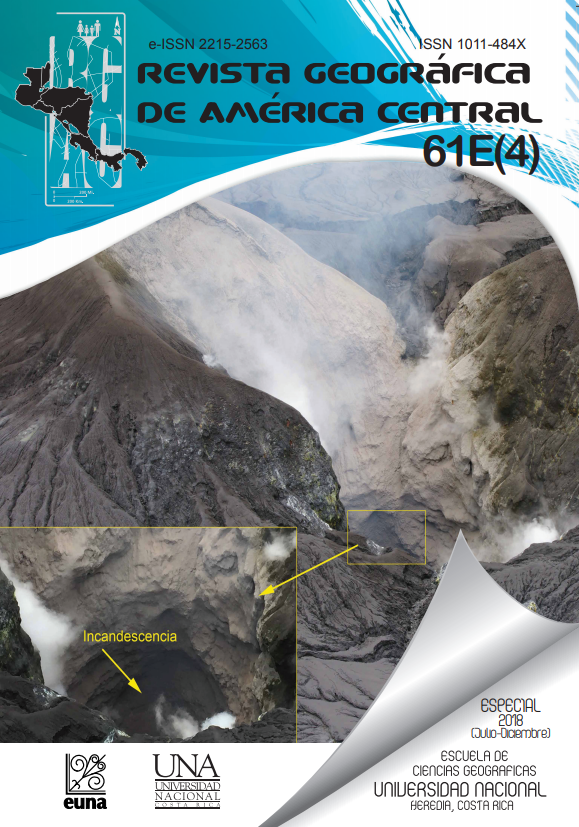Fragmentation and connectivity of the natural cover at county level in Costa Rica, during 2000 and 2015 years
DOI:
https://doi.org/10.15359/rgac.61-4.2Keywords:
nature cover, land use, fragmentation, connectivity, biometric index.Abstract
This research proposes the formulation of a fragmentation / connectivity index that assesses the condition of natural cover at the canton level for Costa Rica based on spatial distribution considering the variables: area of the county, the natural coverage area, the number of fragments and distance of neighborhood between the fragments of the natural cover, for the years 2000 and 2015. The images Landsat 7 for the year 2000 and Landsat 8 for the year 2015 were used where the land use categories for each year were derived through supervised classification with ERDAS software and with ArcMap10.5 biometric indices were estimated using the Vargas equation (2008) which was modified for its application. Within the results, we identified the cantons that present greater or lesser fragmentation and connectivity of their natural coverage during the study period.
References
Acuña, G. (2006). Producción de piña en Caribe y Pacífico Sur de Costa Rica. Ambientico, Revista mensual sobre la actualidad ambiental, 158, 1-3. Heredia. Costa Rica, ISSN 1409-214X
Ambrosio, G. González, J. y Arévalo, V. (s.f.). Corrección radiométrica y geométrica de imágenes para la detección de cambios en una serie temporal. Dpto. Ingeniería de Sistemas y Automática. Universidad de Málaga.
Calvo, A. y Ortiz, E. (2011). Fragmentación de la cobertura forestal en Costa Rica durante los periodos 1997-2000 y 2000-2005. En: Revista Forestal Mesoamericana Kurù, 9(22), 10-21.
Calvo, J., Watson V., Bolaños, R., Quesada C., Sánchez, A, Gonzáles, P. y Ramírez, J. (1999). Estudio de la cobertura forestal de Costa Rica empleando imágenes Landsat 1986/1987 y 1996/1997. Documento presentado en el marco del XI Congreso Agronómico Nacional y de Recursos Naturales. San José, Costa Rica.
Fondo de Financiamiento Forestal de Costa Rica (FONAFIFO). (2012). Estudio de la Cobertura Forestal de Costa Rica 2009-2010. En: htpp: minae.go.cr/recursos/ documentos/coberturas-forestal/estudio-cobertura-forestal-FONAFIFO-marzo-2012.pdf.
FAO. (2016). La cubierta forestal se ha ampliado producto de prácticas agrícolas más sostenibles, la reversión de la deforestación y a los estrictos controles legales implementados. Organización de las Naciones Unidas para la Alimentación y la Agricultura.
Gurrutxaga, M. y Lozano, P. (2006). Efectos de la fragmentación de hábitats y pérdida de conectividad ecológica dentro de la dinámica territorial. Departamento de Geografía, Prehistoria y Arqueología. Universidad del País Vasco. Polígonos. Revista de Geografía, 16, 35-54
Morera, C. (2010). Estructura del Paisaje y Desarrollo Turístico en la Fila Brunqueña, Costa Rica. En: Revista Geográfica de América Central, 44, 91-108.
Morera, C. y Sandoval, L. (2013). Los procesos de fragmentación y la conectividad forestal en Costa Rica: Dos casos de estudios. En: Geografía, Paisaje y Conservación. ECG - UNA. (agregar número y páginas)
Morera, C. y Sandoval, L. (2015). Aplicabilidad de indicadores de estructura de paisaje para evaluar transformaciones en escenarios tropicales. En: Métodos y Técnicas Geográficas Aplicadas al Ambiente: Una Visión Latinoamericana. Universidad Autónoma de San Luis Potosí, México. EUNA, Heredia.
Morera, C. & Sandoval, L. F. (2016). Evaluación de la cobertura boscosa en Costa Rica: un análisis a nivel de áreas de conservación en el año 2000. En Revista Geográfica de América Central, 56(2), 163-182.
Liu, X., Li, X., Chen, Y., Tan, Z., Li, S. & Ai, B. (2010). A new landscape index for quantifying urban expansion using multi-temporal remotely sensed data. In Landscape Ecology, 25, 671-682. https://doi.org/10.1007/s10980-010-9454-5
Priego, A., Bocco, G., Mendoza, M. & Garrido, A. (2008). Propuesta para la generación semi-automatizada de unidades de paisajes. Secretaria de Medio Ambiente y Recursos Naturales Instituto Nacional de Ecología Centro de Investigaciones en Geografía Ambiental Universidad Nacional Autónoma de México. Secretaria de Medio Ambiente y Recursos Naturales (Semarnat México.), México D.F.
Salas, S. y Durán, A. (2015). Caracterización del uso del suelo en las principales áreas agrícolas de la Gran Área Metropolitana (GAM) de Costa Rica. Agronomía Costarricense, 39(1). San Pedro de Montes de Oca.
Sánchez, A., Foley, S., Hamilton, S., Calvo, C., Arroyo, P. y Jiménez, V. (2002). Estudio de Cobertura Forestal de Costa Rica imágenes Landsat TM/ para el año 2000. Centro Científico Tropical. San José, Costa Rica.
Vargas, G. (2008). Fragmentación y conectividad de ecosistemas en el sector del proyecto geotérmico Miravalles y sus alrededores. 19752007. En Revista Reflexiones, 87(2), 9-38.
Valverde, K., Porras, M. y Jiménez, A. (2016). La expansión por omisión: Territorios piñeros en los cantones Los Chiles, Upala y Guatuso, Costa Rica (2004 -2015. Vigésimo Segundo informe estado de la nación en desarrollo humano sostenible. San José. Costa Rica.
Veldkamp, A. & Fresco, L. O. (1996). CLUE-CR: an integrated multi-scale model to simulate land use change scenarios in Costa Rica. Ecological modelling, 91(1), 231-248.
Zamora, P. y Cortés, J. (2009). Los manglares de Costa Rica: el Pacífico Norte. Revista Biología Tropical, 57(3), 473-488. ISSN-0034-7744
Downloads
Published
How to Cite
Issue
Section
License
Proposed policy for journals offering Open Access
Authors publishing their works in the Journal acknowledge and agree to the following terms:
a) Authors retain the copyrights to their works and guarantee the Journal the right to be the first to publish their works, under the Creative Commons License Attribution-NonCommercial-ShareAlike 4.0 International, CC BY-NC-SA 4.0 International (https://creativecommons.org/licenses/by-nc-sa/4.0/deed.es), which allows others to share works upon complying with the acknowledgment of authorship and mention of the Journal as the original publisher of the work.
b) Authors are permitted to separately establish additional agreements for the non-exclusive distribution of the official edition of the work published in the Journal (for example, authors may desire to place the work in an institutional repository or incorporate it into a book that is to published elsewhere) so long they acknowledgment to recognize the Journal as the original publisher. The aforementioned additional agreements must respect the terms of the non-profit character and sharing philosophy of the original license (CC BY-NC-SA 4.0 International, https://creativecommons.org/licenses/by-nc-sa/4.0/deed.es).
c) Authors are encouraged to archive the post-print or editor/PDF version in Open Access repositories.






 REVGEO is licensed under https://creativecommons.org/licenses/by-nc-sa/4.0/deed.es
REVGEO is licensed under https://creativecommons.org/licenses/by-nc-sa/4.0/deed.es
.svg_4.png)

_(1).png)
_(1)_(1)_(1)_1.png)
(2)(1)(1)(1).png)
